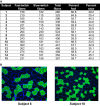Molecular, neuromuscular, and recovery responses to light versus heavy resistance exercise in young men
- PMID: 28963127
- PMCID: PMC5617935
- DOI: 10.14814/phy2.13457
Molecular, neuromuscular, and recovery responses to light versus heavy resistance exercise in young men
Abstract
Recent evidence suggests that resistance training with light or heavy loads to failure results in similar adaptations. Herein, we compared how both training modalities affect the molecular, neuromuscular, and recovery responses following exercise. Resistance-trained males (mean ± SE: 22 ± 2 years, 84.8 ± 9.0 kg, 1.79 ± 0.06 m; n = 15) performed a crossover design of four sets of leg extensor exercise at 30% (light RE) or 80% (heavy RE) one repetition maximum (1RM) to repetition failure, and heavy RE or light RE 1 week later. Surface electromyography (EMG) was monitored during exercise, and vastus lateralis muscle biopsies were collected at baseline (PRE), 15 min (15mPOST), and 90 min following RE (90mPOST) for examination of molecular targets and fiber typing. Isokinetic dynamometry was also performed before (PRE), immediately after (POST), and 48 h after (48hPOST) exercise. Dependent variables were analyzed using repeated measures ANOVAs and significance was set at P ≤ 0.05. Repetitions completed were greater during light RE (P < 0.01), while EMG amplitude was greater during heavy RE (P ≤ 0.01). POST isokinetic torque was reduced following light versus heavy RE (P < 0.05). Postexercise expression of mRNAs and phosphoproteins associated with muscle hypertrophy were similar between load conditions. Additionally, p70s6k (Thr389) phosphorylation and fast-twitch fiber proportion exhibited a strong relationship after both light and heavy RE (r > 0.5). While similar mRNA and phosphoprotein responses to both modalities occurred, we posit that heavy RE is a more time-efficient training method given the differences in total repetitions completed, lower EMG amplitude during light RE, and impaired recovery response after light RE.
Keywords: Electromyography; mammalian target of rapamycin; postexercise recovery; resistance training.
© 2017 The Authors. Physiological Reports published by Wiley Periodicals, Inc. on behalf of The Physiological Society and the American Physiological Society.
Figures







References
-
- Akima, H. , and Saito A.. 2013. Activation of quadriceps femoris including vastus intermedius during fatiguing dynamic knee extensions. Eur. J. Appl. Physiol. 113:2829–2840. - PubMed
-
- Allen, D. G. , Lamb G. D., and Westerblad H.. 2008. Skeletal muscle fatigue: cellular mechanisms. Physiol. Rev. 88:287–332. - PubMed
-
- Baar, K. , and Esser K.. 1999. Phosphorylation of p70S6kcorrelates with increased skeletal muscle mass following resistance exercise. Am. J. Physiol. 276:C120–C127. - PubMed
-
- Beck, T. W. , and Housh T. J.. 2008. Use of electromyography in studying human movement. Routledge, New York.
-
- Bigland‐Ritchie, B. , Cafarelli E., and Vollestad N. K.. 1986. Fatigue of submaximal static contractions. Acta Physiol. Scand. Suppl. 556:137–148. - PubMed
Publication types
MeSH terms
Substances
LinkOut - more resources
Full Text Sources
Other Literature Sources

